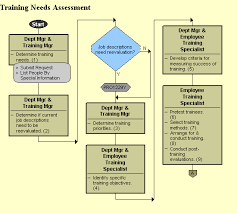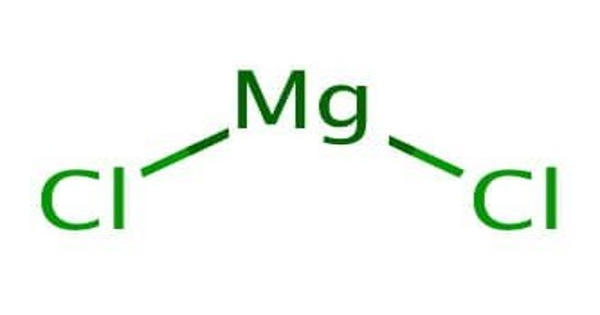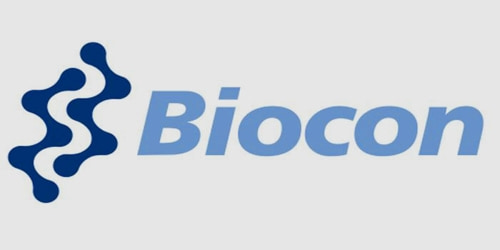BRAC Bank Limited (BBL) is the most dynamic bank now in Bangladesh. BRAC Bank Limited started its journey on the 4th of July 2001 originating from its source BRAC – Bangladesh Rural Advancement Committee. BRAC is known as the one of the most successful NGO in the world. Mainly, BRAC Bank originated due to successful story of BRAC microfinance. Today BRAC Bank is considered as third generation bank extending full range of banking facilities by providing efficient, friendly and modern fully automated on-line service on a profitable basis.
One major area of the HRM function of BBL is particular relevance to the effective use of human resources is Learning and Development. In this paper there is a complete discussion about the current training process, training design and preparation of training, list of training, and mentioned and discuss major area of training and Feedback of employees. And finally work on the process of Training Needs Assessment. By following these processes they providing training on Job Specific Skill, Soft Skill, Technical Skills and Managerial Leadership Skills based Training. The company has particular standard that they need to maintain for each session conducted.
However every time it becomes difficult to evaluate the outcome of Training Needs Assessment of each employees by using rating or scoring process from the trainings and also it is not possible to numerically express the improvement of knowledge, skill and behavior that are use deliver through trainings. As a result in this paper an assessment is shown from Descriptive Method. The existing process of BBL does to match point to point with this descriptive method but it is serving the reason efficiently and cost effectively. However in the upcoming existence current training function will need alteration according to the business need, as a result this assessment may help them for further improvement. . Training is necessary to ensure an adequate supply of staffs that are technically and socially competent and capable of career advancement into specialist department of management position. There is, therefore, a continual need for the process of staff development and training fulfill part of this process.
OBJECTIVE OF THE REPORT:
Broad Objective:
Gain a real life exposure with a business organization to relate with the theoretical practice.
Specific Objectives:
- To understand the business of BRAC Bank Limited
- To Learn and gain knowledge from practical experiences
- To Understand the Learning and Development division process and policy
- To know how to improve relationship between supervisor and subordinate within the bank
- To prepare guidelines for different types of works.
- To conduct a survey through administering a questioner.
- To know the internal strength of L & D division of BRAC Bank Ltd.
- To make some recommendations and conclusion to further the development of Learning and Development division of BRAC Bank Ltd
AN OVERVIEW OF BRAC BANK LIMITED
INTRODUCTION:
A fully equipped commercial Bank, BRAC Bank focuses on perusing uncharted market niches in the Small and Medium Enterprise Business, which till then has remained largely untouched within the country, the Bank has provide support to more than 200000 Small and Medium Enterprise. BRAC Bank is in business is to build a profitable and socially responsible financial institution focused on markets and businesses with growth potential, thereby assisting BRAC and stakeholders build a just, enlightened, healthy, democratic and poverty free Bangladesh.
The banks operate under a “triple bottom line” agenda where people, planet and profit to hand in hand as it strive towards poverty free and enlightened Bangladesh. Since its inception, it has introduced fully integrated first online banking service to provide all kinds of banking facilities from any of its conveniently located branches. Employee Self
Service (ESS) is a web based application that provides employees with access to their Personal Records, enables to perform various HR related activities and supervisors to view their subordinates’ information and consider various requests. Finacle (Banking Core Software) will be able to practice in MIS Test Environment with photocopy material of real time banking transaction. All branch employees have to be qualified by using Finacle Software before their job placement.
BACKGROUND OF BRAC BANK LIMITED:
BRAC Bank Limited started its journey on the 4th of July 2001 originating from its source BRAC – Bangladesh Rural Advancement Committee. BRAC is known as the one of the most successful NGO in the world. It was founded in Bangladesh in 1972 and over the course of our evolution, established itself as a pioneer in recognizing and tackling the many different realities of poverty of which BRAC BANK is one of the largest operational commercial ventures of the group. Mainly, BRAC Bank originated due to successful story of BRAC microfinance. With 157 Branches, SME Service Centers & SME/Krishi Branches, 14 Apon Shomoy, 350+ ATM Booths, 31CDMs, 392 SME office and 399 SME Unit Offices and more than 8,000 + human resources(as on May 2014). With more than 1.0 Million Customers, the bank has already proved to be the largest SME financier in just 12 years of its operation in Bangladesh and continues to broaden its horizon into Retail, Corporate, Foreign Remittance and other arenas of banking.
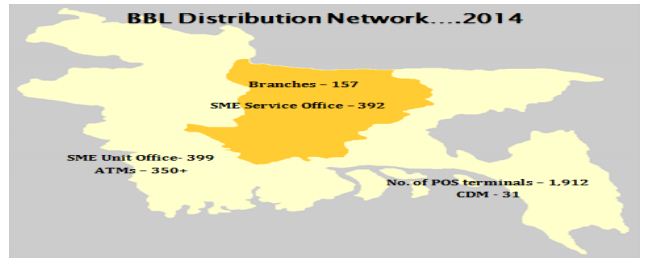
BRAC BANK LIMITED CONCERNS:

SHAREHOLDERS OF BRAC BANK LIMITED:
BRAC bank Limited, with institutional shareholding by BRAC, International Finance Corporation (IFC) and Shore cap International, has been the fastest growing bank for last several years.
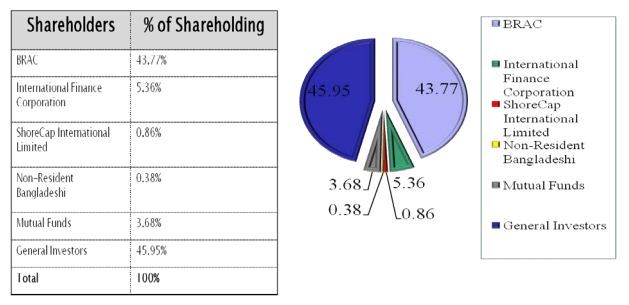
ORGANIZATIONAL STRUCTURE OF BRAC BANK LIMITED:

AN OVERVIEW OF LEARNING & DEVELOPMENT DIVISION
INTRODUCTION
Learning and Development is primarily concerned with organizational activity aimed at bettering the performance of banks employees. Also, L&D has expanded its horizon by providing training for employees of banks subsidiaries as well as for employees of different organizations.
BRAC Bank believes that effective training and development benefits the individual and the organization as a whole, and contributes to the achievement of Banks objectives. These benefits include:
- high standards of work performance
- greater understanding and appreciation of factors affecting work performance
- sharing ideas and dissemination of good practice
- building strong and effective teams
- increased motivation and job satisfaction for individuals
- greater understanding of business.
OBJECTIVE OF LEARNING & DEVELOPMENT
Training of the employees is an integral part to accomplish the mission of BRAC bank. There is a continuous need to support training and employee development to attain the following objectives:
- each employee understands what his or her work role involves
- each employee is developed to enable them to achieve their work objectives
- Employees are prepared and equipped to deal with changes to cope with reorganizations, changing mission requirements and technology or equipment.
- Evolve as a well reputed training institute
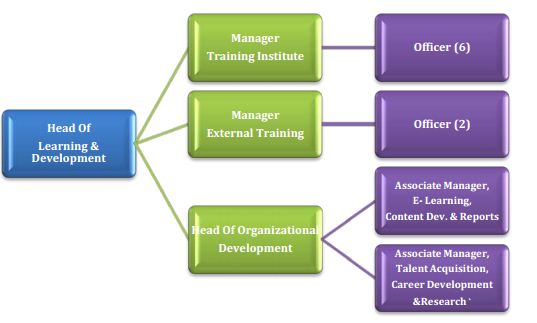
LEARNING
Providing employees with training and development opportunities not only contributes to the quality and effectiveness of the organization but it also serves to motivate and retain employees. The bank’s policy is to train the human resources to enhance skill and knowledge for better understanding of job responsibilities. It includes on-the-job and formal training programs. In each calendar year every employee must complete minimum 30 hrs of training.
TRAINING TECHNIQUES OF BBL:
BBL Authority believes that training is salient thing to achieve organizational goals precisely. Therefore they strictly follow modern and sophisticated training process which is attributable on their existing employees. The BBL authority provides the following techniques in training:
a. On the job training
b. Off the job training
TRAINING PROCESS:
Training process of BRAC BANK LIMITED holds following steps –
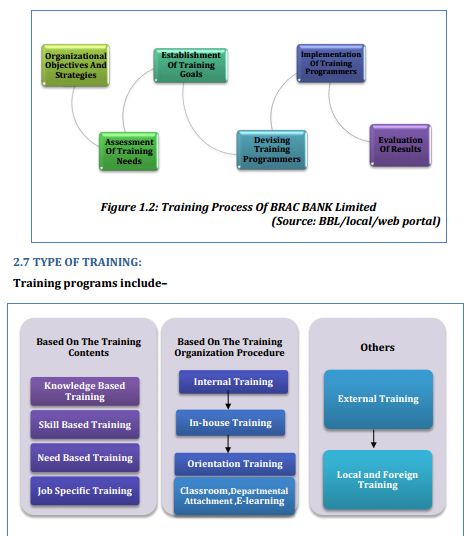

MAJOR FOCUS AREA FOR TRAINING:
- Effective business communication
- Managerial skills development.
- Soft skill and managerial skills development training focusing employees of SME inassociation with IFC.
Training is one of the key focuses in people development in BRAC Bank Limited. BBL HR arranges various kinds of in-house and external training for the staff all through the year. Some of the key trainings provided in 2014 are as follows:
Finacle Certification Program: All newly hired branch employees are required to go through a attachment and a certification process before deployment to the branches. The process is shown on the above chart.
Regionalization of Trainings: We have been able to successfully organize 1) AML & N.I Act, 2) Service Quality & 3) Mock Branch at the different regions of the country. Through this initiative we have been able to reduce significant travel time of the employees outside Dhaka resulting huge cost savings.
Anti-Money Laundering Training: In 2010, our target was to be fully compliant with Central Bank requirement by giving this training to all employees of the bank which we achieved with little variation
Branch Manager Development Program: We have successfully developed and implemented BM development program. In this program we systematically identify potential internal candidates through a set of assessment tools and run them through a set of programs that include classroom training and attachment with cross-functional departments.
TRAINING PARTICIPANTS:
Learning & Development division is not only arranging training to its internal employees but also to the employees of its subsidiaries and employees of other organizations.
Internal Participants : Full Time Employee (FTE), Contractual, Outsource All the regular employ Full Time Employee (FTE) of the bank are eligible to receive training courses At least 75% confirmed Full Time Employee (FTE) will receive minimum 40 hours of training within the following year of joining. Contractual employees will receive only orientation training. Other training courses for the contractual employees are subject to necessity, which will be treated as exception.
FINDINGS AND ANALYSIS:
BRAC BANK Limited does not go for Training Needs Assessment of MTO in first one year of probation period. After one year when probation period will be completed then organization go for Training Needs Assessment as like as general employees. Earlier than MTO stay in general structure of training session. Learning and development will arrange this training around seven months within their training structure. This structure is given below:
Management Trainees (1 year) existing training structure:
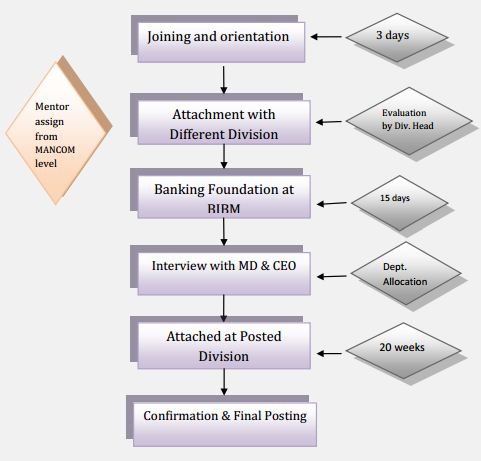
Management Trainee Program
BRAC bank has the following training program for its Management Trainees. The whole training program will be divided into two major parts. One part is the training on foundation courses and the other part includes attachment in core and support business and operations unit.
Joining and orientation: Joining/ participating in orientation with divisional overview and orientation training.
Attachment with different departments: On the basis of organizational structure the trainees will be attached in different departments basically on core business departments and operations departments. Each divisional attachment based on specific combination such as attachment with SME head office, SME Unit Offices & SME Branches. They have to get ideas about divisional activities and values; overall banking knowledge etc. though
combined training like class room training and attaches training.
Banking foundation course: Core banking training comprises of BIBM –
- Foundation course,
- Induction and SME & Retail Attachment.
- Information Technology Training
- On job hands-on training according to Job Description
Mentor assigned: Mentor assign from MANCOM level. Mentor like divisional head provides their subordinate with different assignment, task and attachment for personal development. On the basis of their activities mentor evaluated their performance and provide feedback. Employee’s performance evaluation format and attachment format as a file submitted to the MD and CEO.
Interview with MD & CEO: Every 3 months head of HR, head of L & D will sits with them to follow up on their progress and take individual interview along with MANCOM. After that they evaluate and decide where MTO can be posted.
Attached Posted Division: In this time posted division not finally settled. Functional grade is shown as MTO until they don’t get final position. At this moment divisional head is monitoring employees, on the basis of employees job requirement they provide job specific training for their personal improvement. This training are branch related training, technical training like Finacle (core banking software), service related training etc. and
others additional requirements basis training which is approved by relative departments of divisional head.
Confirmation & Final Posting: After one year MTO will get confirmation letter and final posting. Generally final posting selected from where employee attaches on probation period. The Learning and Development department will conduct this training session. HR department will work as a coordinator for the whole process. At first general structure of training then organization will go for individual Training Needs Assessment. Organization does not start Training Needs Assessment process at the beginning because MTO’s attachment program is running. After one year when probation period is completed and they will get final attach posting, then divisional head of this each particular department provide Training Needs Assessment on the basis of individual need assessment.
Training Needs Assessment of BRAC Bank:
BBL always gives priority to need assessment to avoid errors in training. Assessment of training needs focus on anticipated skills of an employee. Technology changes fast and new technology demands new skills. Individuals require new skills because of possible job rotation. It is given to the employees after analyzing the gap between skills and knowledge and competency required for the current role. It can be either overseas or local.
The main purpose of Training Needs Assessment is
If any lacking on job performance, from training to eliminate this lacking and perform job in an accurate way.
Determination of Training Program based on Training Needs Assessment:

Training Needs Assessment will determine by the regular structure of training. At first employee’s training requirement decided by their respective divisional head. Then supervisor will decide which training is needed on the basis of employee’s gap or Performance Management. Supervisor decides employees Training Needs Assessment
from the format of training list where all kinds of training are mentioned and on the basis of that training will provide. Individual Training Needs Assessment makes around seven (7) months. When employees get division ways attach positing after that each departmental divisional head will place employees’ requirement to their respective
divisional supervisors. For example, in treasure dept. needs specialist for collection loan in proper way, on the basis of departmental need training will provide which need is decided by departmental head.
i. Training period: At the end of month and at the end of the June training not provided because business pressure is so high in bank. So training provided within first to middle days (1 to 15) date of month. In exceptional case training will provide on weekend day (Friday to Saturday) for additional development. In December there is no training because year closing factor.
ii. Budget for Training: There are so many divisions in BBL. For example of SME division, around 4.5 core budget fixed for this department for 1,450 Customer Service Officer. They are all technical people. So it focused on soft skill knowledge based training like selling technique. Training provide in a uniform way.
Sources of Training Needs Assessment:
In organization for different positions role, day by day this position role becomes bigger. Because of bigger position here come others role, a manager not expert to play this all roles. He needs to train to expert this new job role which is his next year Training Needs Assessment. When perform job if employee’s absent indentify for performing particular job, to mitigate this lacking and which area need to improve where training are needed. That is employees Training Needs Assessment, in this approach Training Needs Assessment is developed day by day.
Major components for conducting Training Needs Assessment:
The three levels of the needs analysis are interrelated and data need to be collected at all levels for the analysis to be effective. Based on the information gathered, management can identify training needs, establish learning objectives, and develop a training program that meets organizational and employee needs.
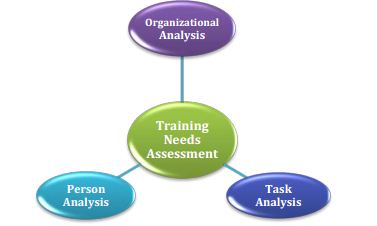
I. Organizational analysis: Organizational analysis examines where training is needed and under what conditions the training will be conducted. It identifies the knowledge, skills and abilities that employees will need for the future as the organization and their jobs alter or change. The organizational analysis stage also should plan for workplace changes, such as skills needed in the future, workforce demographics, and evolving laws and regulations.
Future Skills: understanding how an organization may be altering helps to identify skill needs. When certain pool of employees job role are changes because of organizational factor, then need training of this certain level of employees. This type of needs arise from organization which is organizational analysis. For example: BRAC BANK decides to change their business style. Say, in ATM they don’t use card, now they want to start figure touch system. In this business need some employees developed by training. So this type of training needs occurred from organization
employees individual needs. Organization decides which pool of employee come up this particular training, employees who involved in alternate banking chain, they should train.
Workforce Demographics: As the economy changes and operating costs adjust, the workplace may need to change. For example, if BRAC BANK becoming a global organization will require changes. Understanding the
effects of such changes help an organization better accommodate employee’s needs.
Laws & Regulations: Changes in safety and environmental regulations as well as adoption of other laws may order that an organization provide training in specific areas. For example is the Regulatory Need, which need requirement comes from Bangladesh Bank; this bank is regulatory body for all bank of Bangladesh. If Bangladesh Bank feels BRAC BANK employees need that particular training like as “Anti money laundering” training, then employees must able to take this training.
II. Task analysis: Operations/task analysis examines each job’s knowledge and skills requirements and compares these requirements to employees’ actual knowledge and skills. Any gaps indicate a training need. If employees need any training for perform his task when job role is change or newly entry employee of this job that is task analysis. For example: when employees job role are changed say, from Learning & Development if any Manager shift to Corporate business division so change his job role. For this certain level he need some training, so this is task based Training Needs Assessment.
III. Person analysis: Individual analysis examines a worker and how s/he is performing the assigned job. An employee can be interviewed, questioned or tested to determine individual level of skill or knowledge. Data also can be collected from performance reviews.
For self development when employee’s needed training that started from person’s job specific of job analysis. When deficiencies are identified, training can be established to meet the individual employee’s needs. For example: interpersonal skills, managerial skills, leadership skills, behavioral skills etc. these types of training needed for employees personal improvement.
The three levels of the needs analysis are interrelated and data need to be collected at all levels for the analysis to be effective. Based on the information, management can identify training needs, establish learning objectives and develop a training program.
How Training Needs Assessment conducted:
Needs analysis is a process that consists of a series of interrelated steps. The process starts with a problem, if problem is important then stakeholder are consulted and needs assessment is conducted

Training afford basically depends on employee’s Job Analysis, for example as analyzing branch manager job. If training provided on the basis of job analyzing, training are credit analysis, documentation, financial statement analysis, investigation skills etc. this kind of training required. Analysis what kind of major positions company have and on the position wise what kind of training are needed for employees. For Example:

Here this is the Job description of Senior Manager of Learning and Development division. In this job requirement if manager dose not perform in one feature that is his Training Need. Say for example, in job requirement if manager does not provide Training Facilitation in a proper way, where purpose is not serve so lacking in facilitation quality. Another is Budgeting, calculative method unable to use in Excel, but others requirement for performing job are excellent, so that he needs to train up for developing in two areas. Supervisor can send him in Advance Training. That is Training Needs Assessment which appear from employees Job Description.

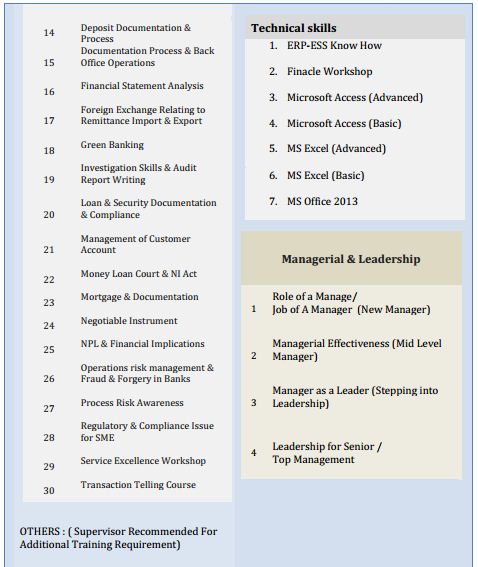
Learning and Development division provide training list on the basis of employee’s requirement to each division supervisors. Then supervisor set Training needs assessment support on training list. Basically, Training needs assessment conducted by person job description which comes from Job Analysis. First, observe how many major positions in bank, and then take large division’s job description. Analyses for perform this particular division what are the current responsibilities, knowledge, skills and abilities employees have, that means which requirements are needed to perform employee’s job description.
Supervisor is responsible to analysis this factors, he has to analysis what current skills employees already have, what skills employees are needed and find out knowledge gap area from Job Analysis. After identify the gap of his subordinates, the supervisor recommend required training to the Learning and Development division (L&D). L&D match training list with supervisor recommend required training. If supervisor think that additional training are required for his subordinates which is not include in training list, he may mention it “OTHERS” in training list form.
Each departmental supervisor fixed under subordinates individual Training Needs Assessment. Then submit this request of Training Needs Assessment list to L&D. then they are compile and analysis how many employees need this specific training. On the basis of requested training demand they fixed training batch, allocate resource person may be internally or externally, and then arrange training program. For internal trainer, venue and calendar wise training arrange and for external trainer, need to know this particular institutions’ training date and time and then training will arrange.
In this way, from employees Job Description that indentify required skills, on the basis of requirement and training list at the end of each year set each department of individual employee’s Training Needs Assessment.
RECOMMENDATION:
- BBL face different kinds of Challenges one is sufficient training sometimes not included in training list but particular training urgent for employees. That means list of training is generalize category where personal need basis to arrange training not possible. For example: specific need based training is difficult to arrange for few numbers of employees. Say, five numbers of employees they need training immediately, for this particular employee to arrange training program is difficult. At that time they will go for external training, though training can be arrange by externally but which is not included in Training Needs Assessment category and more cost required. Therefore, for making an effective Training Need Analysis of employees, effective training list should be integrated which can be arranged internally and less cost required. For example, collection is another important sector in BRAC BANK Limited because non performing loan is very high which hamper regular banking activities. So, Effective training such as collection related training is very emerging training.
- Additional challenge BRAC BANK Limited face is when training list provide from learning and development division to supervisor of different departments. If any supervisor think that additional training is needed which is not include in training list, they will mention it in “OTHERS” that indicate additional training requirement. Training list is huge when they include additional training requirement. Say, 4000+ employees’ supervisor put 4000 types training requirement from this list it is very difficult to approach in a unique way and Training Needs Assessment identify also difficult. So training awareness create, to provide proper knowledge about Training Needs Assessment, how Training Needs Assessment conducted this kind of training should
provide.
- Sometimes supervisors recommended training list which not clearly recognize. All supervisors do not hold same level of knowledge. Say, area manager of unit office they don’t have enough knowledge which hold on Head office Manager, most of the cases they don’t understand soft skills based training. So supervisor need training such as selecting training which components are essential, when making training list the background of training should provide to respective supervisors that he get descriptive idea about this particular training.
- Supervisor who is selected Training Needs Assessment for his subordinates, how much knowledgeable this supervisor? Is supervisor access properly to his subordinates? Whether supervisor selected Training Needs Assessment in a proper way or not? Can employee realize what kind of training he has to need? That all are challenging issues when indentify Training Needs Assessment. So, training not only provide subordinate, it is also provide for supervisor. For example, NLP (Neuron Linguistic Program) based training is a part of managerial leadership training which helpful to understand human psychological behavior. If supervisor can take this training they will able to identify with employees need more effectively and make efficiently Training Needs Assessment under his subordinates. So, this training can be provided for supervisor improvement.
Moreover, not only supervisor, under his subordinate can also suggest for Training Needs. Here both have to clear concept about Training Needs Assessment. - Another aspect, employee fills desired performance but what will be the next after 2 or 3 years when employee get promotion or job role shifting as like as Junior Officer to Manager level job role. In this time for different role organization can provide training even though employees gap not exist. For playing future role training can be arranged by leadership role, managerial role basis training.
BBL basically follows first three steps, last step they don’t apply. Investment versus Return evaluation is essential evaluation aspect in organization. BBL believes training is an investment not an expense. From this point of view after the training session how much employees give return that evaluation supposed to be required. We can develop some tools such as if manager leads the sales team, organization observe this manager has some lacking to lead the team so he needs training. Manager goes for training though some invention, training like- managerial skills,
perceptional skills, cultural values and changes etc. Suppose, organization invest 20,000 tk. for this particular Manager, after 2 or 3 three months return is higher than investment. Say, return is 4 laces whether before training return was 2 laces only. Moreover, this Investment Verse Return evaluation where investment against return is high that helps to increase employee’s retention, discharge or termination also decrease. So, this kind of evaluation is desirable.
CONCLUSION:
Learning and Development activities require to be aligned with the organization’s policy to be effective workforce. Part of the alignment process of BRAC BANK Limited is the development of training unit tactics in support of the organization’s policy. Need Assessment is the cornerstone and foundation of training. In fact, it is often referred to as
important step in the Learning and Development process of this organization. Providing employees with training and development opportunities not only contribute to the quality and effectiveness of the organization, it also serves to motivate and retain employees.
Moreover, according to BRAC BANK training is not an expense but an investment. In this regard the objective base and performance driven activity of the training function of BRAC BANK Limited is very well aligned with the organization goal and helping a lot to achieve it. However, a perfect Training need assessment will be a little benefit unless organization has created a supportive learning environment. Organization need inspire a sense of purpose in
employees and create the opportunities for them to learn.
